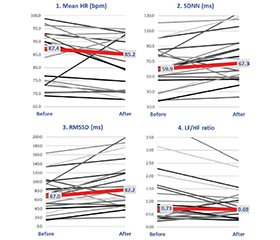Международный неврологический журнал Том 21, №6, 2025
Вернуться к номеру
Вплив спінальної маніпуляції на варіабельність серцевого ритму в дітей із церебральним паралічем: пілотне дослідження
Авторы: O.O. Kachmar (1), N.V. Kozyavkinа (1), A.D. Kushnir (1), O.V. Kozyavkina (1), D.V. Popovych (2), N. Zeniou (3), A.M. Kuzan (1)
(1) - Kozyavkin International Rehabilitation Clinic, Truskavets, Ukraine
(2) - I. Horbachevsky Ternopil National Medical University, Ternopil, Ukraine
(3) - Physiotherapy & Acupuncture Centre, Limassol, Cyprus
Рубрики: Неврология
Разделы: Клинические исследования
Версия для печати
Актуальність. Мета цього пілотного дослідження полягала у вивченні впливу спінальної маніпуляції (СМ), що застосовується в рамках методу професора Козявкіна, на варіабельність серцевого ритму (ВСР) у дітей із дитячим церебральним паралічем (ДЦП). ВСР є неінвазивним показником функціонального стану вегетативної нервової системи (ВНС) та загальної адаптаційної здатності організму. Зниження ВСР пов’язане з порушенням регуляції ВНС, що часто спостерігається в дітей із ДЦП, особливо при виражених моторних розладах. Матеріали та методи. У дослідженні взяли участь сім пацієнтів із ДЦП віком 4–18 років, які проходили двотижневу програму реабілітації за методом Козявкіна. Варіабельність серцевого ритму вимірювали шість разів на трьох етапах курсу — на початку, у середині та наприкінці. Під час кожної сесії проводили два вимірювання ВСР: перед і після СМ. Усього було проаналізовано 42 записи (21 парне вимірювання). Результати. Виявлено статистично значущі зміни всіх досліджуваних показників ВСР. Середнє значення SDNN, що відображає загальну варіабельність серцевого ритму, зросло з 59,9 до 67,3 мс (p < 0,01). Показник RMSSD, який переважно характеризує парасимпатичну активність, збільшився з 67,0 до 82,2 мс (p < 0,01). Середнє значення LF/HF знизилося з 0,73 до 0,69 (p < 0,05), що свідчить про зміщення балансу ВНС у бік підвищення вагусної активності. Також зафіксовано незначне, але статистично значуще зниження частоти серцевих скорочень (p < 0,05). Висновки. Отримані результати демонструють, що спінальна маніпуляція може сприяти поліпшенню автономної регуляції та підвищенню парасимпатичної активності в дітей із ДЦП. Дослідження вказує на можливість використання ВСР як об’єктивного біомаркера для оцінки ефективності нейрореабілітаційних втручань. Подальші масштабні рандомізовані дослідження необхідні для визначення довгострокових ефектів СМ та її потенційного впливу на функціональні результати реабілітації.
Background. The purpose of this pilot study was to investigate the effects of spinal manipulation (SM), applied within the framework of Professor Kozyavkin’s Method, on heart rate variability (HRV) in children with cerebral palsy (CP). HRV is a non-invasive marker of autonomic nervous system function and overall adaptive capacity. Reduced HRV has been associated with impaired autonomic regulation, which is commonly observed in children with CP, particularly in cases with greater motor dysfunction. Materials and methods. Seven children with CP aged 4–18 years participated in a two-week rehabilitation program based on the Kozyavkin Method. HRV was assessed six times at three stages of the course — at the beginning, in the middle, and end of rehabilitation. During each session, two HRV recordings were obtained: before and after SM. In total, 42 recordings were analyzed, resulting in 21 paired measurements. Results. The results demonstrated statistically significant changes in all measured HRV parameters. Median SDNN, reflecting overall heart rate variability, increased from 59.9 to 67.3 ms (p < 0.01). RMSSD, primarily associated with parasympathetic activity, increased from 67.0 to 82.2 ms (p < 0.01). The LF/HF ratio decreased from 0.73 to 0.69 (p < 0.05), indicating a shift toward enhanced vagal activity. A slight but statistically significant reduction in mean heart rate was also observed (p < 0.05). Conclusions. These findings suggest that spinal manipulation may improve autonomic regulation and enhance parasympathetic activity in children with CP. HRV appears to be a useful objective biomarker for evaluating the effectiveness of neurorehabilitation interventions. Further large-scale randomized controlled studies are needed to confirm these results and explore the long-term effects of SM on functional rehabilitation outcomes.
спінальна маніпуляція; варіабельність серцевого ритму; церебральний параліч; вегетативна нервова система
spinal manipulation; heart rate variability; cerebral palsy; autonomic nervous system

